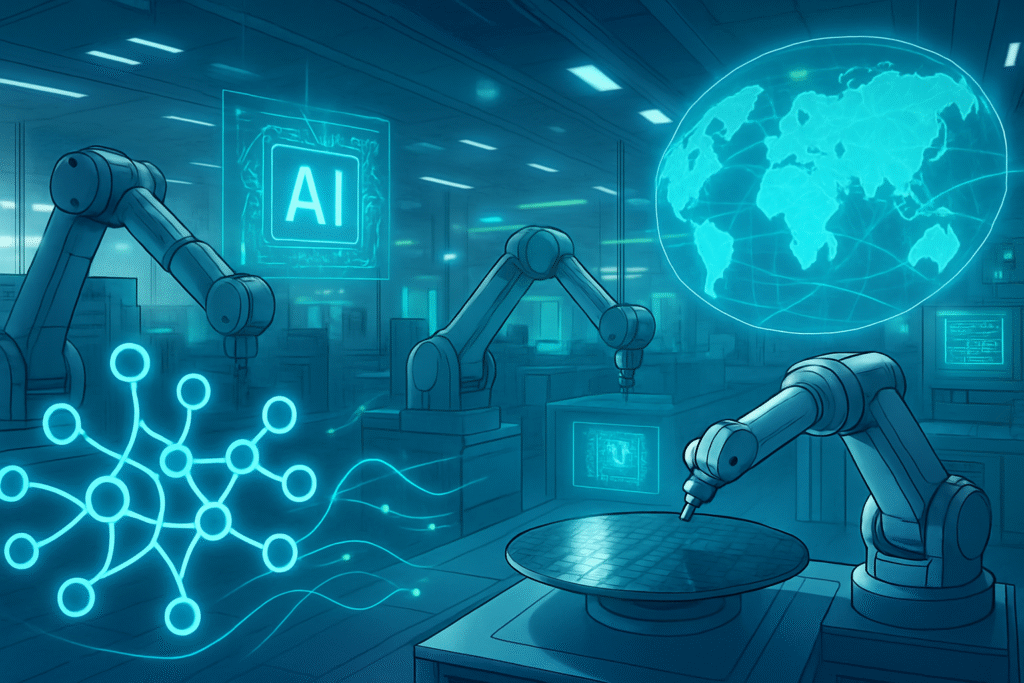
The global landscape of artificial intelligence (AI) and advanced technology is currently undergoing a monumental shift, largely driven by an unprecedented "AI Supercycle" that has ignited a fierce, government-backed race for semiconductor supply chain resilience. As of October 2025, nations worldwide are investing staggering sums and implementing aggressive policies, not merely to secure their access to vital chips, but to establish dominance in the next generation of AI-powered innovation. This concerted effort marks a significant pivot from past laissez-faire approaches, transforming semiconductors into strategic national assets crucial for economic security, technological sovereignty, and military advantage.
The immediate significance of these initiatives, such as the U.S. CHIPS and Science Act, the European Chips Act, and numerous Asian strategies, is the rapid re-localization and diversification of semiconductor manufacturing and research. Beyond simply increasing production capacity, these programs are explicitly channeling resources into cutting-edge AI chip development, advanced packaging technologies, and the integration of AI into manufacturing processes. The goal is clear: to build robust, self-sufficient ecosystems capable of fueling the insatiable demand for the specialized chips that underpin everything from generative AI models and autonomous systems to advanced computing and critical infrastructure. The geopolitical implications are profound, setting the stage for intensified competition and strategic alliances in the digital age.
The Technical Crucible: Forging the Future of AI Silicon
The current wave of government initiatives is characterized by a deep technical focus, moving beyond mere capacity expansion to target the very frontiers of semiconductor technology, especially as it pertains to AI. The U.S. CHIPS and Science Act, for instance, has spurred over $450 billion in private investment since its 2022 enactment, aiming to onshore advanced manufacturing, packaging, and testing. This includes substantial grants, such as the $162 million awarded to Microchip Technology (NASDAQ: MCHP) in January 2024 to boost microcontroller production, crucial components for embedding AI at the edge. A more recent development, the Trump administration's "America's AI Action Plan" unveiled in July 2025, further streamlines regulatory processes for semiconductor facilities and data centers, explicitly linking domestic chip manufacturing to global AI dominance. The proposed "GAIN AI Act" in October 2025 signals a potential move towards prioritizing U.S. buyers for advanced semiconductors, underscoring the strategic nature of these components.
Across the Atlantic, the European Chips Act, operational since September 2023, commits over €43 billion to double the EU's global market share in semiconductors to 20% by 2030. This includes significant investment in next-generation technologies, providing access to design tools and pilot lines for cutting-edge chips. In October 2025, the European Commission launched its "Apply AI Strategy" and "AI in Science Strategy," mobilizing €1 billion and establishing "Experience Centres for AI" to accelerate AI adoption across industries, including semiconductors. This directly supports innovation in areas like AI, medical research, and climate modeling, emphasizing the integration of AI into the very fabric of European industry. The recent invocation of emergency powers by the Dutch government in October 2025 to seize control of Chinese-owned Nexperia to prevent technology transfer highlights the escalating geopolitical stakes in securing advanced manufacturing capabilities.
Asian nations, already powerhouses in the semiconductor sector, are intensifying their efforts. China's "Made in China 2025" and subsequent policies pour massive state-backed funding into AI, 5G, and semiconductors, with companies like SMIC (HKEX: 0981) expanding production for advanced nodes. However, these efforts are met with escalating Western export controls, leading to China's retaliatory expansion of export controls on rare earth elements and antitrust probes into Qualcomm (NASDAQ: QCOM) and NVIDIA (NASDAQ: NVDA) over AI chip practices in October 2025. Japan's Rapidus, a government-backed initiative, is collaborating with IBM (NYSE: IBM) and Imec to develop 2nm and 1nm chip processes for AI and autonomous vehicles, targeting mass production of 2nm chips by 2027. South Korea's "K-Semiconductor strategy" aims for $450 billion in total investment by 2030, focusing on 2nm chip production, High-Bandwidth Memory (HBM), and AI semiconductors, with a 2025 plan to invest $349 million in AI projects emphasizing industrial applications. Meanwhile, TSMC (NYSE: TSM) in Taiwan continues to lead, reporting record earnings in Q3 2025 driven by AI chip demand, and is developing 2nm processes for mass production later in 2025, with plans for a new A14 (1.4nm) plant designed to drive AI transformation by 2028. These initiatives collectively represent a paradigm shift, where national security and economic prosperity are intrinsically linked to the ability to design, manufacture, and innovate in AI-centric semiconductor technology, differing from previous, less coordinated efforts by their sheer scale, explicit AI focus, and geopolitical urgency.
Reshaping the AI Industry: Winners, Losers, and New Battlegrounds
The tidal wave of government-backed semiconductor initiatives is fundamentally reshaping the competitive landscape for AI companies, tech giants, and startups alike. Established semiconductor giants like Intel (NASDAQ: INTC), TSMC (NYSE: TSM), and Samsung Electronics (KRX: 005930) stand to be primary beneficiaries of the billions in subsidies and incentives. Intel, with its ambitious "IDM 2.0" strategy, is receiving significant U.S. CHIPS Act funding to expand its foundry services and onshore advanced manufacturing, positioning itself as a key player in domestic chip production. TSMC, while still a global leader, is strategically diversifying its manufacturing footprint with new fabs in the U.S. and Japan, often with government support, to mitigate geopolitical risks and secure access to diverse markets. Samsung is similarly leveraging South Korean government support to boost its foundry capabilities, particularly in advanced nodes and HBM for AI.
For AI powerhouses like NVIDIA (NASDAQ: NVDA), the implications are complex. While demand for their AI GPUs is skyrocketing, driven by the "AI Supercycle," increasing geopolitical tensions and export controls, particularly from the U.S. towards China, present significant challenges. China's reported instruction to major tech players to halt purchases of NVIDIA's AI chips and NVIDIA's subsequent suspension of H20 chip production for China illustrate the direct impact of these government policies on market access and product strategy. Conversely, domestic AI chip startups in regions like the U.S. and Europe could see a boost as governments prioritize local suppliers and foster new ecosystems. Companies specializing in AI-driven design automation, advanced materials, and next-generation packaging technologies are also poised to benefit from the focused R&D investments.
The competitive implications extend beyond individual companies to entire regions. The U.S. and EU are actively seeking to reduce their reliance on Asian manufacturing, aiming for greater self-sufficiency in critical chip technologies. This could lead to a more fragmented, regionalized supply chain, potentially increasing costs in the short term but theoretically enhancing resilience. For tech giants heavily reliant on custom silicon for their AI infrastructure, such as Google (NASDAQ: GOOGL), Amazon (NASDAQ: AMZN), and Microsoft (NASDAQ: MSFT), these initiatives offer a mixed bag. While reshoring could secure their long-term chip supply, it also means navigating a more complex procurement environment with potential nationalistic preferences. The strategic advantages will accrue to companies that can adeptly navigate this new geopolitical landscape, either by aligning with government priorities, diversifying their manufacturing, or innovating in areas less susceptible to trade restrictions, such as open-source AI hardware designs or specialized software-hardware co-optimization. The market is shifting from a purely cost-driven model to one where security of supply, geopolitical alignment, and technological leadership in AI are paramount.
A New Geopolitical Chessboard: Wider Implications for the AI Landscape
The global surge in government-led semiconductor initiatives transcends mere industrial policy; it represents a fundamental recalibration of the broader AI landscape and global technological order. This intense focus on chip resilience is inextricably linked to the "AI Supercycle," where the demand for advanced AI accelerators is not just growing, but exploding, driving unprecedented investment and innovation. Governments recognize that control over the foundational hardware for AI is synonymous with control over future economic growth, national security, and geopolitical influence. This has elevated semiconductor manufacturing from a specialized industry to a critical strategic domain, akin to energy or defense.
The impacts are multifaceted. Economically, these initiatives are fostering massive capital expenditure in construction, R&D, and job creation in high-tech manufacturing sectors, particularly in regions like Arizona, Ohio, and throughout Europe and East Asia. Technologically, the push for domestic production is accelerating R&D in cutting-edge processes like 2nm and 1.4nm, advanced packaging (e.g., HBM, chiplets), and novel materials, all of which are critical for enhancing AI performance and efficiency. This could lead to a rapid proliferation of diverse AI hardware architectures optimized for specific applications. However, potential concerns loom large. The specter of a "chip war" is ever-present, with increasing export controls, retaliatory measures (such as China's rare earth export controls or antitrust probes), and the risk of intellectual property disputes creating a volatile international trade environment. Over-subsidization could also lead to overcapacity in certain segments, while protectionist policies could stifle global innovation and collaboration, which have historically been hallmarks of the semiconductor industry.
Comparing this to previous AI milestones, this era is distinct. While earlier breakthroughs focused on algorithms (e.g., deep learning revolution) or data (e.g., big data), the current phase highlights the physical infrastructure—the silicon—as the primary bottleneck and battleground. It's a recognition that software advancements are increasingly hitting hardware limits, making advanced chip manufacturing a prerequisite for future AI progress. This marks a departure from the relatively open and globalized supply chains of the late 20th and early 21st centuries, ushering in an era where technological sovereignty and resilient domestic supply chains are prioritized above all else. The race for AI dominance is now fundamentally a race for semiconductor manufacturing prowess, with profound implications for international relations and the future trajectory of AI development.
The Road Ahead: Navigating the Future of AI Silicon
Looking ahead, the landscape shaped by government initiatives for semiconductor supply chain resilience promises a dynamic and transformative period for AI. In the near-term (2025-2027), we can expect to see the fruits of current investments, with high-volume manufacturing of 2nm chips commencing in late 2025 and significant commercial adoption by 2026-2027. This will unlock new levels of performance for generative AI models, autonomous vehicles, and high-performance computing. Further out, the development of 1.4nm processes (like TSMC's A14 plant targeting 2028 mass production) and advanced technologies like silicon photonics, aimed at vastly improving data transfer speeds and power efficiency for AI, will become increasingly critical. The integration of AI into every stage of chip design and manufacturing—from automated design tools to predictive maintenance in fabs—will also accelerate, driving efficiencies and innovation.
Potential applications and use cases on the horizon are vast. More powerful and efficient AI chips will enable truly ubiquitous AI, powering everything from hyper-personalized edge devices and advanced robotics to sophisticated climate modeling and drug discovery platforms. We will likely see a proliferation of specialized AI accelerators tailored for specific tasks, moving beyond general-purpose GPUs. The rise of chiplet architectures and heterogeneous integration will allow for more flexible and powerful chip designs, combining different functionalities on a single package. However, significant challenges remain. The global talent shortage in semiconductor engineering and AI research is a critical bottleneck that needs to be addressed through robust educational and training programs. The immense capital expenditure required for advanced fabs, coupled with the intense R&D cycles, demands sustained government and private sector commitment. Furthermore, geopolitical tensions and the ongoing "tech decoupling" could lead to fragmented standards and incompatible technological ecosystems, hindering global collaboration and market reach.
Experts predict a continued emphasis on diversification and regionalization of supply chains, with a greater focus on "friend-shoring" among allied nations. The competition between the U.S. and China will likely intensify, driving both nations to accelerate their domestic capabilities. We can also expect more stringent export controls and intellectual property protections as countries seek to guard their technological leads. The role of open-source hardware and collaborative research initiatives may also grow as a counter-balance to protectionist tendencies, fostering innovation while potentially mitigating some geopolitical risks. The future of AI is inextricably linked to the future of semiconductors, and the next few years will be defined by how effectively nations can build resilient, innovative, and secure chip ecosystems.
The Dawn of a New Era in AI: Securing the Silicon Foundation
The current wave of government initiatives aimed at bolstering semiconductor supply chain resilience represents a pivotal moment in the history of artificial intelligence and global technology. The "AI Supercycle" has unequivocally demonstrated that the future of AI is contingent upon a secure and advanced supply of specialized chips, transforming these components into strategic national assets. From the U.S. CHIPS Act to the European Chips Act and ambitious Asian strategies, governments are pouring hundreds of billions into fostering domestic manufacturing, pioneering cutting-edge research, and integrating AI into every facet of the semiconductor lifecycle. This is not merely about making more chips; it's about making the right chips, with the right technology, in the right place, to power the next generation of AI innovation.
The significance of this development in AI history cannot be overstated. It marks a decisive shift from a globally interconnected, efficiency-driven supply chain to one increasingly focused on resilience, national security, and technological sovereignty. The competitive landscape is being redrawn, benefiting established giants with the capacity to expand domestically while simultaneously creating opportunities for innovative startups in specialized AI hardware and advanced manufacturing. Yet, this transformation is not without its perils, including the risks of trade wars, intellectual property conflicts, and the potential for a fragmented global technological ecosystem.
As we move forward, the long-term impact will likely include a more geographically diversified and robust semiconductor industry, albeit one operating under heightened geopolitical scrutiny. The relentless pursuit of 2nm, 1.4nm, and beyond, coupled with advancements in heterogeneous integration and silicon photonics, will continue to push the boundaries of AI performance. What to watch for in the coming weeks and months includes further announcements of major fab investments, the rollout of new government incentives, the evolution of export control policies, and how the leading AI and semiconductor companies adapt their strategies to this new, nationalistic paradigm. The foundation for the next era of AI is being laid, piece by silicon piece, in a global race where the stakes could not be higher.
This content is intended for informational purposes only and represents analysis of current AI developments.
TokenRing AI delivers enterprise-grade solutions for multi-agent AI workflow orchestration, AI-powered development tools, and seamless remote collaboration platforms.
For more information, visit https://www.tokenring.ai/.





